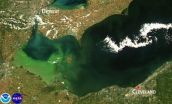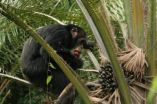(Press-News.org) NOAA and its research partners predict that western Lake Erie will have a significant bloom of cyanobacteria, a toxic blue-green algae, during the 2014 bloom season in late summer. However, the predicted bloom is expected to be smaller than last year's intense bloom, and considerably less than the record-setting 2011 bloom.
Bloom impacts will vary across the lake's western basin and are classified by an estimate of both its concentration and how far it spreads.
Harmful algal blooms (HABs) were common in western Lake Erie between the 1960s and 1980s. After a lapse of nearly 20 years, blooms have been steadily increasing over the past decade. Since 2008, NOAA has issued weekly HAB bulletins for western Lake Erie through the National Centers for Coastal Ocean Science (NCCOS) to give warnings of bloom development. Also, this marks the third time NOAA has issued an annual outlook for western Lake Erie.
"The reemergence of harmful algal blooms in Lake Erie is an ecological and economic setback for communities along the coast," U.S. Representative Marcy Kaptur said. "NOAA, Ohio Sea Grant, OSU, Heidelberg University and University of Toledo are developing tools to predict and target phosphorus, which will help in the fight to restore balance to Lake Erie's ecosystem, Ohio's greatest natural resource."
"The Lake Erie harmful algal bloom forecast, combined with NOAA's weekly HAB Bulletins, underscores the importance of having accessible and reliable environmental intelligence so the public and environmental health specialists can make informed decisions," said Holly Bamford, assistant NOAA administrator for the National Ocean Service. "With this information, we can work collectively to understand harmful algal blooms and mitigate risk to humans and marine ecosystems."
"This NOAA model, resulting from a great collaboration, has been incredibly valuable to us as we work to eliminate blooms to protect human health, the Lake Erie ecosystem and its coastal economy," said Jeff Reutter, Ph.D., director of Ohio State University's Sea Grant program and Stone Laboratory. "In Ohio, as part of the Ohio Phosphorus Task Force II, we have used information from the NOAA model to help us target reductions in the amount of phosphorus going into the lake that should help us greatly reduce or eliminate the HABs."
The 2014 seasonal forecast used models developed by NCCOS scientists, the coastal science office for NOAA's National Ocean Service. The forecast uses a 12-year Lake Erie nutrient flow data set, collected by Heidelberg University's National Center for Water Quality Research, and analysis of satellite data from the European Space Agency's ENVISAT and NASA's Terra and Aqua satellites.
Separately, a jointly funded University of Michigan Water Center and NOAA Great Lakes Environmental Research Laboratory (GLERL) independent HAB experimental model concurs with the 2014 forecast. In addition to the satellite monitoring, GLERL, Ohio State University's Sea Grant program and Stone Laboratory, Heidelberg University, the University of Toledo, and Ohio EPA will be collecting key measurements from the lake as the summer progresses. Those results will provide valuable information to regional managers and assist NCCOS scientists in further refining the accuracy of this forecast's models.
"Issuing and evaluating these seasonal forecasts improves our understanding of how the blooms form, which leads to strategies to reduce their impacts," said Richard Stumpf, Ph.D., NOAA's ecological forecasting applied research lead at NCCOS. "Our academic partnerships also support us in making improvements to the forecast, further helping managers monitor the bloom, and informing the public of where and when they can best use this great lake."
The Lake Erie forecast is part of a NOAA ecological forecasting initiative that aims to deliver accurate, relevant, timely, ecological forecasts and important environmental data directly to coastal resource managers and the public as part of its stewardship and scientific mandates for coastal, marine and Great Lakes resources. Weekly updates of bloom location and severity can be received by a subscription to the NOAA Lake Erie HAB Bulletin.
Additionally, NOAA currently provides, or is developing, HABs and hypoxia forecasts for the Gulf of Maine, Chesapeake Bay, the Gulf of Mexico and the Pacific Northwest. Funding to support the Lake Erie forecasts was provided through NCCOS, NOAA's Center of Excellence for Great Lakes and Human Health, and NASA's Applied Science Health and Air Quality Program.
INFORMATION:
The research programs supporting this work are authorized under the Harmful Algal Bloom and Hypoxia Research and Control Act, known as HABHRCA, which was amended and reauthorized by Congress in June through 2018.
NOAA's mission is to understand and predict changes in the Earth's environment, from the depths of the ocean to the surface of the sun, and to conserve and manage our coastal and marine resources. Join us on Twitter, Facebook and our other social media channels.
NOAA, partners predict significant harmful algal bloom in western Lake Erie this summer
Overall bloom will be smaller than in 2013 with varying impacts across lake's western basin
2014-07-10
ELSE PRESS RELEASES FROM THIS DATE:
CNIO scientists develop technology to redirect proteins towards specific areas of the genome
2014-07-10
The Spanish National Cancer Research Centre (CNIO) Macromolecular Crystallography Group has managed to reprogramme the binding of a protein called BuD to DNA in order to redirect it towards specific DNA regions. Guillermo Montoya, the researcher who led the study, says the discovery: "will allow us to modify and edit the instructions contained in the genome to treat genetic diseases or to develop genetically-modified organisms." The study is published in the journal Acta Crystallographica, Section D: Biological Crystallography.
The possibility of making à la carte modifications ...
New technology reveals insights into mechanisms underlying amyloid diseases
2014-07-10
Amsterdam, NL, 10 July 2014 – Amyloid diseases, such as Alzheimer's disease, type 2 diabetes, cataracts, and the spongiform encephalopathies, all share the common trait that proteins aggregate into long fibers which then form plaques. Yet in vitro studies have found that neither the amylin monomer precursors nor the plaques themselves are very toxic. New evidence using two-dimensional infrared (2D IR) spectroscopy has revealed an intermediate structure during the amylin aggregation pathway that may explain toxicity, opening a window for possible interventions, according ...
What you eat may affect your body's internal biological clock
2014-07-10
Food not only nourishes the body but also affects its internal biological clock, which regulates the daily rhythm of many aspects of human behavior and biology. Researchers reporting in the Cell Press journal Cell Reports provide new insights into how adjusting the clock through dietary manipulation may help patients with various conditions and show that insulin may be involved in resetting the clock.
An internal biological or 'circadian' clock plays an important role in preferred sleep times, times of peak alertness, and the timing of certain physiological processes. ...
Mediterranean fish stocks show steady decline
2014-07-10
While careful management has helped stabilize or even improve the state of fisheries resources in some parts of Europe, the situation in the Mediterranean has deteriorated over the past 20 years. In a new report evaluating nine fish species reported in the Cell Press journal Current Biology on July 10, scientists call for stringent monitoring of Mediterranean fishing activities, better enforcement of fisheries regulations, and advanced management plans in Mediterranean waters.
Their data show that the fishing pressure in the Mediterranean intensified continuously from ...
Chimpanzee intelligence depends on genes
2014-07-10
Some chimpanzees are smarter than others, and about half of that variation in intelligence depends on the genes that individuals carry and pass on from one generation to the next. The findings reported in the Cell Press journal Current Biology on July 10 show that those genetic differences will be key to understanding the cognitive abilities of primates and their evolution over time.
"As is the case in humans, genes matter when it comes to cognitive abilities in chimpanzees," says William Hopkins of the Yerkes National Primate Research Center. "It doesn't mean that they ...
Hunger for vegetable oil means trouble for Africa's great apes
2014-07-10
The vegetable oil found in your popcorn or soap might not be ape friendly, and the situation appears likely to get even worse, according to an analysis in the Cell Press journal Current Biology on July 10.
The growing demand for vegetable oil has already led to the conversion of Southeast Asian forest into oil palm plantations, bringing trouble for orangutans in particular. If guidelines are not put in place very soon, researchers say the spread of those large-scale industrial plantations from Asia into Africa will be bad news for great apes there as well.
"The first ...
New compound treats both blindness and diabetes in animal studies
2014-07-10
In a new study led by UC San Francisco (UCSF) scientists, a chemical compound designed to precisely target part of a crucial cellular quality-control network provided significant protection, in rats and mice, against degenerative forms of blindness and diabetes.
In addition to opening a promising drug-development path for the wide range of diseases caused by cell loss, the new research offers a new view of the workings of the unfolded protein response (UPR), a cellular "life-or-death" signaling network: When cells are under stress, the UPR works to ensure that they produce ...
Chimpanzee intelligence determined by genes
2014-07-10
ATLANTA–A chimpanzee's intelligence is largely determined by its genes, while environmental factors may be less important than scientists previously thought, according to a Georgia State University research study.
The study found that some, but not all, cognitive, or mental, abilities, in chimpanzees depend significantly on the genes they inherit. The findings are reported in the latest issue of Current Biology.
"Intelligence runs in families," said Dr. William Hopkins, professor in the Center for Behavioral Neuroscience at Georgia State and research scientist in the ...
Climate change may bring more kidney stones
2014-07-10
As daily temperatures increase, so does the number of patients seeking treatment for kidney stones. In a study that may both reflect and foretell a warming planet's impact on human health, a research team found a link between hot days and kidney stones in 60,000 patients in several U.S. cities with varying climates.
"We found that as daily temperatures rise, there is a rapid increase in the probability of patients presenting over the next 20 days with kidney stones," said study leader Gregory E. Tasian, M.D., M.Sc., M.S.C.E., a pediatric urologist and epidemiologist at ...
In the gut, immunity is a 2-way street
2014-07-10
In recent years, it has become increasingly clear that many diseases are triggered or maintained by changes in bacterial communities in the gut. However, the general view up into now has been rather simple: bacteria stimulate the immune system, leading to inflammation or autoimmune disorders in a single direction.
Now, in work published in Immunity, scientists led by Sidonia Fagarasan from the RIKEN Center for Integrative Medical Science in Japan have painted a more complex picture: the gut immune system does not simply prevent the influx of pathogens, but is actively ...
LAST 30 PRESS RELEASES:
Making lighter work of calculating fluid and heat flow
Normalizing blood sugar can halve heart attack risk
Lowering blood sugar cuts heart attack risk in people with prediabetes
Study links genetic variants to risk of blinding eye disease in premature infants
Non-opioid ‘pain sponge’ therapy halts cartilage degeneration and relieves chronic pain
AI can pick up cultural values by mimicking how kids learn
China’s ecological redlines offer fast track to 30 x 30 global conservation goal
Invisible indoor threats: emerging household contaminants and their growing risks to human health
Adding antibody treatment to chemo boosts outcomes for children with rare cancer
Germline pathogenic variants among women without a history of breast cancer
Tanning beds triple melanoma risk, potentially causing broad DNA damage
Unique bond identified as key to viral infection speed
Indoor tanning makes youthful skin much older on a genetic level
Mouse model sheds new light on the causes and potential solutions to human GI problems linked to muscular dystrophy
The Journal of Nuclear Medicine ahead-of-print tip sheet: December 12, 2025
Smarter tools for peering into the microscopic world
Applications open for funding to conduct research in the Kinsey Institute archives
Global measure underestimates the severity of food insecurity
Child survivors of critical illness are missing out on timely follow up care
Risk-based vs annual breast cancer screening / the WISDOM randomized clinical trial
University of Toronto launches Electric Vehicle Innovation Ontario to accelerate advanced EV technologies and build Canada’s innovation advantage
Early relapse predicts poor outcomes in aggressive blood cancer
American College of Lifestyle Medicine applauds two CMS models aligned with lifestyle medicine practice and reimbursement
Clinical trial finds cannabis use not a barrier to quitting nicotine vaping
Supplemental nutrition assistance program policies and food insecurity
Switching immune cells to “night mode” could limit damage after a heart attack, study suggests
URI-based Global RIghts Project report spotlights continued troubling trends in worldwide inhumane treatment
Neutrophils are less aggressive at night, explaining why nighttime heart attacks cause less damage than daytime events
Menopausal hormone therapy may not pose breast cancer risk for women with BRCA mutations
Mobile health tool may improve quality of life for adolescent and young adult breast cancer survivors
[Press-News.org] NOAA, partners predict significant harmful algal bloom in western Lake Erie this summerOverall bloom will be smaller than in 2013 with varying impacts across lake's western basin





